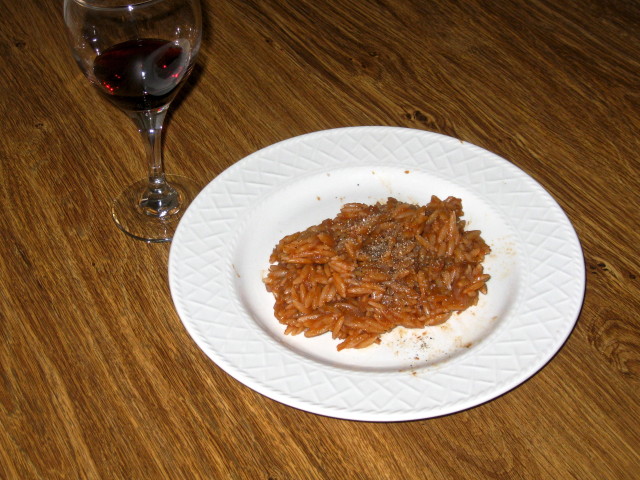
Manestra is on of the childhood memories dishes. One of those dishes, that were made on special occasions, and you could eat as much as you could handle. It is one of the dishes that can be made in the middle of winter and brings a cozy feelings to the heart. None of my cooking books do not discuss the origin or the history of the book. However my personal feeling guides me to the so called “yuvetsi”. It is the big cousin of manestra, made similarly, with the same ingredients but different procedures. The name yuvetsi accounts for the earthenware used to make it, a pot with the clay-coloured interior and curved handles. It is Bulgarian in origin (Gyuvech), and it is the original name of the earth-ware dish traditionally use to make it. Nowadays it is used widely for many types of dishes. Manestra is the pot version of the dish. Although the whole dish with the meat is better the right procedures can make any dish equally good, even without any meat. So let ‘s get started.

The ingredients are very simple:
- 1 can of 16 oz of tomatoes sauce (not pureé or paste)
- 1 can of chicken/beef stock
- 1 package (3 cups of orso, greek brand preferably)
- 2 small tomatoes (to yield about 1 cup of graded tomatoes)
- 1 large onion
- 1 green peper (poblano)
- Olive oil
- salt and pepper

Start by peeling the onion, cut it lengthwise, and make vertical cuts spaced about 1/4 inch (1/2 cm).

Follow with horizontal cuts.

and cut it small pieces.

When done pass the knife over a few times to mince them even more finely.

Cut the top of the tomatoes and…

pass them form a box grader. You can use a food processor, but the texture is not quite as good. I love the result of the box grader, and I don ‘t change it for anything.

Add the some olive oil tot he pan and let it warm up over medium heat.

Add the onions…

and a pinch (heavy I might add) pinch of salt and a few grinds of pepper. Yeah no picture for the pepper but you should know how to add the pepper (geeezzz).

Cut the pepper roughly in large pieces. We will add it only fot he taste, so we will need to fish it out later.

Add the in them in the simmering onions. Let them cook for 2-3 mins.

Now add the graded tomatoes. You can skip them, but the dish will be missing some freshness. As you can see in the middle of winter, the tomatoes are not as red. Simmer for 3-4 minutes.

Fish out the pepper and let them aside.

Now crank the heat to high, and see the thick steam gushing out.

The mixture will thicken up up and the kitchen will smell with tomato fragrance.

I enjoy cooking with wine, sometimes I even put it in the food I’m cooking.
– Julia Child
Add the wine. What ever you have around. I added some Cabarnet-Savignon. And that brings us to a great topic in cooking: cooking with wine. Many people say that you should cook with a wine you would drink. Although that is somewhat true, it is not universal. Cooking the wine will literally beat up its character. Nothing of the quality will remain. You don ‘t really taste much of the wine. So just use a mediocre wine. A drinkable wine. Not a very funky tasting, but not an expensive. I used one that was medium acidity, to bring out the more complex character of the tomato sauce, and counter the acidity. You should not use a white wine, since it is fruity and it does not blend well with the tomato. However, you can skip the wine all together, but your sauce will be missing its depth.

Add a cup of tomato sauce and…

…follow it with the chicken stock. Let it simmer for 10-15 min over medium-low heat. You can just use water here. You will just be peeling of one more layer of taste, but still it will be great.

While it is cooking, you can pour another glass of wine, take the peppers we fished out before and glance outside the window… Enjoy the moment. When it is done it will look like this. Smooth, rich but still watery. If you continue cooking till it thickens up it will become a great sauce for pasta.

Now pour it an a glass volumetric bowl to measure it. For each cup of orso we need 2 cups of sauce. Yeah I know don ‘t everyone has that bowl, but… go get one… or calibrate one. What is missing we will add later. Here I am a few tbsp shorter than 4 cups. If I cooked with the lid on I would be at 4 cups sharp, but not a biggie.

Now go back to your pot (no need to clean it) and add some olive oil (2-3 tbsp).

Add the orso. This is the most important part of the procedure. The orso has to be fully coated with oil. That will seal and the starch will not leech out to make the orso sticky and ugly looking.

Let it cook over high heat till it slightly turn color.

Add the sauce and stir like crazy. The pan is hot, and there will be steam, but keep your cool.

And the 2 cups of cooking liquid. In this case it was the rest of the stock and water. Let it cook over medium low heat till it is done. Stir occasionally, to prevent sticking and to achieve more uniform cooking. The botom of the pot gets more heat than the top, stirring will guarantee that the orso cooks uniformly.

Once cooked (meaning soft but still yielding) smooth the surface and let sit for a few minutes uncovered. That will le the extra steam escape to make the dish a bit more firm.

At this point you can grind some fresh pepper and and enjoy with a glass of wine. Here it is the same as the one I used for the sauce. It is an excellent wine to pair it with the tomato and the pasta.


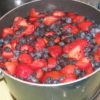
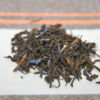

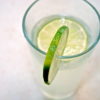
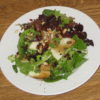

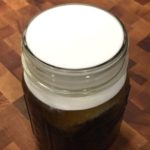

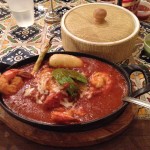
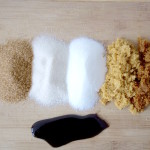
Leave a Reply